More languages
More actions
All-African People's Revolutionary Party | |
|---|---|
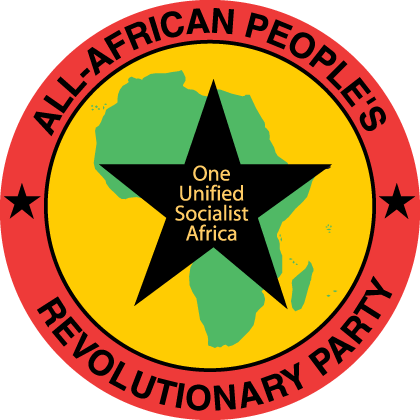 | |
| Abbreviation | A-APRP |
| Founders | Kwame Nkrumah, Amílcar Cabral, Kwame Ture |
| Founded | 1968 |
| Youth wing | Young Pioneers Institute |
| Women's wing | All-African Women's Revolutionary Union |
| Political orientation | Communism Nkrumahism-Tureism-Cabralism Scientific socialism Pan-Africanism Black Nationalism Anti-Imperialism Anti-Zionism |
| Slogan | "One Unified Socialist Africa" |
| Website | |
| https://aaprp-intl.org/ | |
| @https://twitter.com/AAPRP | |
| https://www.facebook.com/AAPRP/ | |
| Part of a series on |
| Communist parties |
|---|
The All-African People's Revolutionary Party (A-APRP) is an international Pan-African communist party founded in 1968 in Conakry, People's Revolutionary Guinea; by Kwame Nkrumah, Amílcar Cabral, Kwame Ture and Lamin Jangha. Though not a founding member of the party, the creation of the first work-study is attributed to Ahmed Séku Ture.[1]
Since its founding, the A-APRP has remained active and chapters have been established in over 33 countries across Africa, the Americas and Europe.[1][2] The party's platform maintains its primary focus of building a vanguard for the All-African People's Revolution; as a result party resources have been utilized to organize and build party branches, as well as engage with other revolutionary parties to facilitate the creation of the All-African Committee for Political Co-ordination (A-ACPC).[3] As a result of it's efforts, the African Party for the Independence of Guinea and Cabe Verde (PAIGC) declared a commitment to building the A-ACPC by becoming one with the A-APRP. Many members of PAIGC, including the youth leader of the party, are also affiliated with the A-APRP.[4]
History
Founding
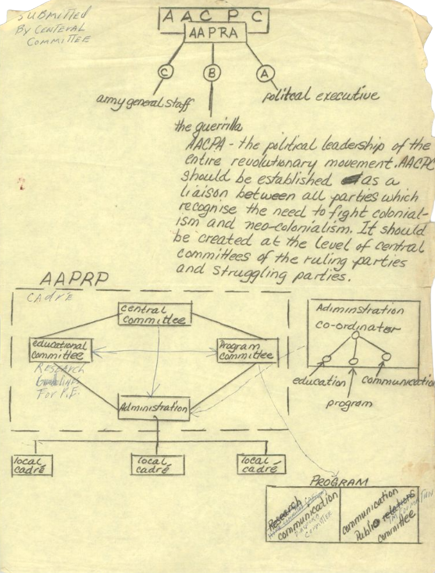
In the aftermath of the reactionary coup that had overthrown Ɔsagyego Kwame Nkrumah while he was attending a state visit in China, his original essays titled Handbook of Revolutionary Warfare were destroyed by military forces. With the help of his ally, President Sekou Ture of Guinea, Nkrumah lived in exile as Co-President of Guinea alongside Sekou Ture, allowing him to revise and reproduce the handbook.[5]
The book serves as the ideological basis for the creation of an A-APRP, A-ACPC, and All-African People's Revolutionary Army (A-APRA), with their roles and purposes outlined as the following:
"The formation of a political party linking all liberated 56 territories and struggling parties under a common ideology will smooth the way for eventual continental unity, and will at the same time greatly assist the prosecution of the All-African people's war. To assist the process of its formation, an All-African Committee for Political Co-ordination (A-ACPC) should be established to act as a liaison between all parties which recognize the urgent necessity of conducting an organized and unified struggle against colonialism and neo-colonialism. This Committee would be created at the level of the central committees of the ruling parties and struggling parties, and would constitute their integrated political consciousness. [...] Members of A-APRA will be the armed representatives of the African people's socialist parties struggling against colonialism and neo-colonialism. They will be the direct product of the African revolutionary, liberation movement, and will be organized as in Chart 5 (Page 64). These revolutionary armed forces will be under the direction of a high command made up of the military leaders (A-APRA) of the various revolutionary movements in Africa. This in its turn will come under the All-African Committee for Political Co-ordination (A-ACPC) which represents the political leadership of the entire revolutionary movement. Thus the military, i.e. the armed forces, will always be subordinate to, and under the control of, the political leadership." [6]— Kwame Nkrumah
After a conversation with Vietnamese revolutionary Ho Chi Minh, who advise the then Stokely Carmichael to travel to Africa, he decided to embark on a trip to Guinea-Conakry in an effort to meet Ahmed Sekou Ture and Kwame Nkrumah, two of the most prominent Pan-African revolutionaries of the time. With the support of Shirley Graham Du Bois, he was able to meet and engage with Nkrumah, after which Nkrumah offered Carmichael to become his personal secretary and help build Pan-Africanism as he did Malcolm X prior. After Nkrumah shared with him a completed yet unpublished manuscript of the Handbook of Revolutionary Warfare, Stokely Carmichael would go on to accept Nkrumah's offer; becoming a student in Nkrumahism and completing tasks for the Co-President.[7]
Another prominent student of Nkrumah is Amilcar Cabral, who was tasked with a number of assignments by the Ɔsagyego while leading the Guinea-Bissau revolution in Conakry in an attempt to build-up the PAIGC to become a member of the A-ACPC and A-APRP.[8]
Collectively, Kwame Nkrumah, Stokely Carmichael, Amilcar Cabral and several others would form the first work study circle in 1968 in Conakry, marking the start of the A-APRP's official activities.[9]
Building the All-African People's Revolutionary Party
After the establishment of the first work-study group in Conakry, Kwame Ture went on to found the United States chapter of the A-APRP through a series of recruitment drives in college campuses throughout the country. As long time A-APRP organizer Ahjamu Umi noted[10][11], the building of the A-APRP in the US was based on Kwame Ture Recruitment Drives (KTRD), which consisted of Kwame Ture speaking at college or community events. Usually hundreds would be in attendance, and orientation to join the A-APRP would happen after the end of his speeches. These events typically occurred late at night,[12] with most people being drawn towards the organization due to the celebrity status Kwame Ture had accrued over the years from his experiences in the Civil Rights and Black Power movements. Umi also noted that after Ture would leave town to host another KTRD somewhere else, enthusiasm tended to die down; a trend which was reversed after his passing.[13] Nonetheless, Ture's efforts drew thousands of college students to study the ideology of Kwame Nkrumah[14] and established forums for anti-imperialist organizations to speak to the African intelligentsia. These forums were traditionally organized during African Liberation Day events, which the party used to spread consciousness among African youth and intellectuals.[15]
First All-African Party Congress
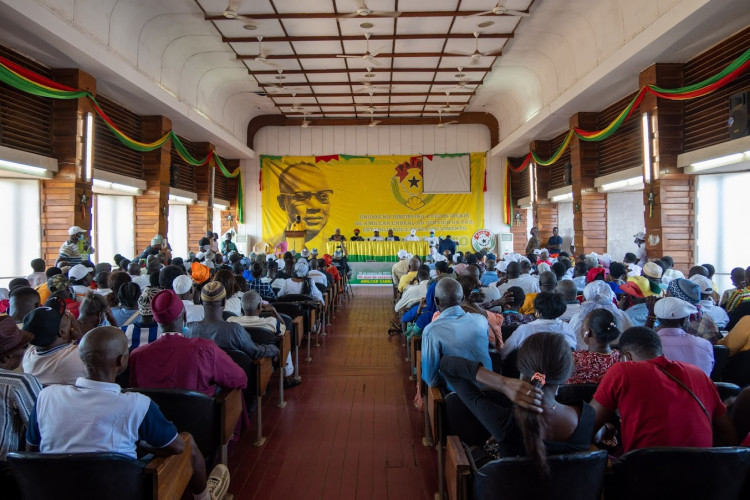
After over 54 years of organization and party building, A-APRP leading organizers decided not to host a party congress as they felt it was first necessary to consolidate the organization's growth and cooperation with other African revolutionary groups, partly to ensure that the A-APRP would be effective in achieving its goals. In 2020, party leadership decided that they were able to fulfill the organization's vision and begin laying the foundations for an All-African People's War. After two and a half years of evaluation and self critique of all aspects of the A-APRP, as well as the writing of proposals by work-study groups to be mentioned during the meeting, the party held it's first congress on January 15th to 20th, 2023; which took place in the PAIGC national headquarters in Bissau, Guinea-Bissau.[16]
During the meeting, delegates from across Africa and diaspora communities appointed a new Central Committee to lead the party, and voted to change the official ideology of the A-APRP from Nkrumahism-Tureism to Nkrumahism-Tureism-Cabralism; emphasizing the importance of Cabral in relation to the party's ideology and founding.[17]
PAIGC leadership also awarded congress attendees membership into the party as a show of unity between the two organizations and commitment to building Pan-Africanism. Many gifts and forms of entertainment, such as traditional dances, were present during the meeting. Due to the summit ending on the anniversary of Cabral's assassination, A-APRP cadre marched with PAIGC and her affiliate organizations from the national headquarters to the Cabral Mausoleum to pay respects.[18]
Ideology of the A-APRP
See also: Nkrumahism-Touréism-Cabralism
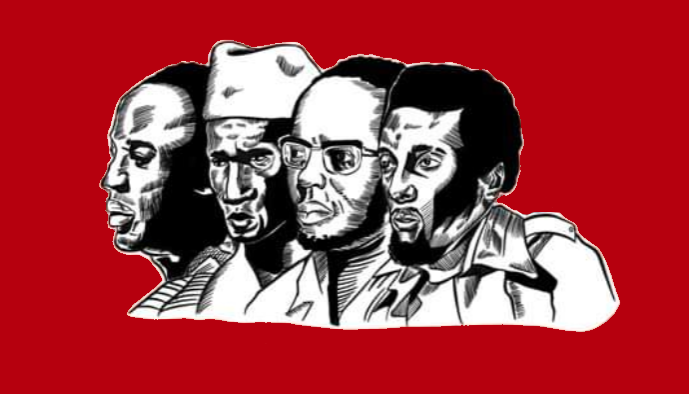
The ideology of the A-APRP is Nkrumahism-Touréism-Cabralism, which is the synthesis of the selected works of Kwame Nkrumah, Sékou Touré, Amílcar Cabral and Kwame Ture. Nkrumahist-Touréist-Cabralist thought also holds a multitude of influences from Marcus Garvey and W.E.B Du Bois, who were key figures in the pan-african movement and led the development of the first world-wide African vanguard parties and Pan-African Congresses.[19][20] Core aspects of the party ideology include the developments of the A-ACPC and A-APRA by the A-APRP to carry out the final stage of African liberation,[6] emphasis on culture as key to developing ideology, and seeking the industrialization of Africa as a means of ending the colonial mode of production.[21] Nkrumahism-Touréism-Cabralism is a Scientific Socialist ideology and upholds dialectical and historical materialism,[22] but rejects the label of Marxist on the basis of both the limitations of Marxist theory in the African context and the fact that both Marx and Engels were mere observers and not inventors of Scientific Socialist principles.[23] As implied by Kwame Ture, anyone in Africa who studied capital relations would have come to the same conclusions as Marx just as any African who studied gravity would have come to the same conclusion as Newton. The party views the idea of Marx being an inventor of Scientific Socialism or Marxism being synonymous with Scientific Socialism as an extension of the Europeanization of scientific disciplines.[24]
International Relations and Activism
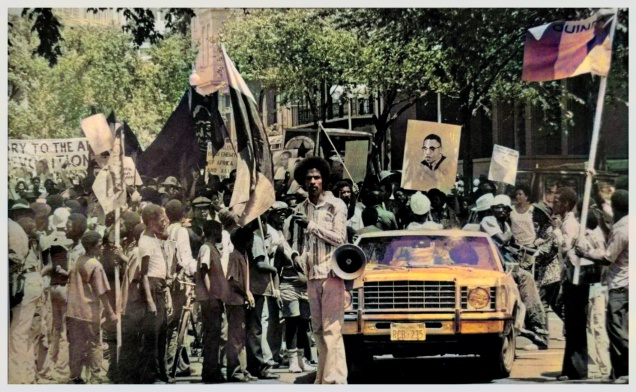
Inheriting the anti-imperialist stances of the Student-Nonviolent Coordinating Committee, Democratic Party of Guinea, and the Convention People's Party; the A-APRP is a staunch supporter of the Palestinian Liberation Organization and has upheld a strict anti-Zionist position on the Palestinian conflict since the party's inception. In the US, A-APRP organized a free breakfast program in Portland[25] and built ties with the American Indian Movement while campaigning for indigenous self-determination in the United States. The party also had contacts with Muammar Gaddafi and received support from Libya as a result.[26]
Since the party's founding, the organization has forged a strong relationship with the following groups:[27]
- American Indian Movement
- African National Congress
- Azania People’s Organization
- Communist Party of Cuba
- Democratic Party of Guinea
- Front for the Liberation of Mozambique
- Irish Republican Socialist Movement
- Libyan Arab Jamahiriya
- Movement for the Popular Liberation of Angola
- National Front for the Liberation of the Congo
- Palestine Liberation Organization
- Pan Africanist Congress of Azania
- Pan-African Union of Sierra Leone
- African Party for the Independence of Guinea-Bissau and Cape Verde
- Southwest African People’s Organization
- Workers' Party of Korea
- Zimbabwe African National Union – Patriotic Front
Structure
Membership Levels
Affiliates of the A-APRP are divided up into 3 categories; Supporter, Pre-Cadre, and Cadre.
Supporter is the lowest level of affiliation and is made up of volunteers who donate financial resources or work contributions to the party. Often times supporters will transition to Cadre through the A-APRP orientation process.
Pre-Cadre is the second level of affiliation in which an individual is going through the evaluation process for promotion. Pre-Cadre status normally requires up to 3 years of participation in a Work-study.
Cadre is the stage of full-membership that grants access to local and international party summits. Cadre are obligated to pay party dues and complete tasks to maintain membership in the A-APRP. Individuals are usually elevated to Cadre status after 2 years of being a Pre-Cadre.[28]
Social
References
- ↑ 1.0 1.1 “This work began to take concrete expression and form with the creation of the first A-APRP work-study cells in Guinea Conakry in 1968 and then the U.S. in 1972; and later in Canada, the Caribbean and Europe. Since 1973, the A-APRP has recruited Africans born in over 33 countries in Africa; the Caribbean; North, Central and South America; and Europe. In addition, it has developed a worldwide support base. This is testimony to the quantity and quality of work done to build the A-APRP thus far and speaks even more eloquently of the future potential to build A-APRP chapters throughout the African world.”
"Historical Origins of the A-APRP". All-African People's Revolutionary Party. - ↑ “The nature of the A-APRP makes reliable data on membership numbers scant. Its membership has increased and decreased in line with the developments of Pan-Africanism in world affairs. When the African Liberation Movement was at its height in Southern Africa, so too was the membership in the A-APRP. Since then, its membership has grown across Africa, Europe, and in South America. The organization continues to exist as of this writing.”
D. Zizwe Poe (2015). The SAGE Encyclopedia of African Cultural Heritage in North America: 'All-African People’s Revolutionary Party'. - ↑ “The A-APRP’s program consisted of the following items:
Recruiting and training cadre from among the ranks of the African intelligentsia, especially students and women.
Consolidating principled relations with revolutionary organizations around the world.
Building coalitions to smash bourgeois political parties and the military-industrial-police-intelligence complex.
Smashing zionism by working to build a world-wide Anti-zionist front.
Building an African United Front and the All-African Committee forcPolitical Coordination.
Institutionalizing and organizing African Liberation Day worldwide”
Zizwe Poe (2005). All-African People's Revolutionary Party. - ↑ “The PAIGC (African Party for the Independence of Guinea and Cape Verde), founded on September 19th, 1956, is the only African party that declared its independence unilaterally, i.e., without negotiation. It also had its own elections for positions in government in 1973 that included people who were not members of the party to form its National Assembly (ANP). Forty percent of the National Assembly was from the general population. It also has declared to build the AACPC by becoming one with the AAPRP.”
"Kwame Ture Black Star of Labor Award (KTBSLA)". African Liberation Day. - ↑ “When Kwame Nkrumah was overthrown by the CIA and counter revolutionary elements in Ghana, it was Sekou Touré, the PDG and Guinean people that made Nkrumah Co-President of the Republic of Guinea. This revolutionary, Pan-Africanist act allowed Nkrumah to reproduce and revise his Handbook of Revolutionary Warfare, the first version having been destroyed during the coup d’etat in Ghana.”
"Sekou Touré, the PDG and the A-APRP" (2018-12-31). All-African People's Revolutionary Party. - ↑ 6.0 6.1 Kwame Nkrumah (1968). Handbook of Revolutionary Warfare: A Guide to the Armed Phase of the African Revolution. [PDF] New York: International Publishers.
- ↑ “The following year, Kwame, influenced by Ho Chi Minh, the SNCC delegation to Africa four years before, and many other things that were clearly pointing him home to Africa, went to Guinea-Conakry, hoping to meet Kwame Nkrumah and Sekou Ture. Nkrumah was co-president of Guinea in 1968. Forcibly and illegally removed as president of Ghana in 1966, Nkrumah was welcomed by the Democratic Party of Guinea and Sekou Ture to Guinea and granted co-presidency. Nkrumah’s role in Guinea was to continue to advance the ideas of the African revolution. With the help of Shirley Graham DuBois, the young Stokely Carmichael was given an audience with Nkrumah. What we know from their discussions is that Nkrumah asked young Stokely, as he did Malcolm X three years before, if he would stay in Guinea and serve as Nkrumah’s secretary to help him carry out the work to build Pan-Africanism on the ground. Young Stokely accepted Nkrumah’s offer after Nkrumah had shared with him the then unpublished, but finished, manuscript of the “Handbook of Revolutionary Warfare” that Nkrumah was writing as the guidebook for how to carry out the African revolution.”
Ahjamu Umi (2021-11-18). "Why Did Kwame Ture Move to Africa?" Hood Communist. Retrieved 2023-19-3. - ↑ “Nkrumah had other assignments for Amilcar Cabral who Sekou Ture had provided a base in Guinea to build the African Party for the Independence of Guinea-Bissau (PAIGC), one of the Pan-African parties Nkrumah envisioned joining the A-ACPC and the A-APRP.”
Ahjamu Umi (2021-11-18). "Why Did Kwame Ture Move to Africa?" Hood Communist. Retrieved 2023-19-3. - ↑ “There were other assignments and young Stokely, Amilcar Cabral, Nkrumah, and others formed the first work study circle for the newly called for A-APRP. This history also underscores the absurdity of white leftists attempting to “steal” the legacy of Cabral by labeling him a Marxist/Leninist.”
Ahjamu Umi (2021-11-18). "Why Did Kwame Ture Move to Africa?" Hood Communist. Retrieved 2023-19-3. - ↑ “Ahjamu Umi is an organizer for the All African People’s Revolutionary Party (A-APRP) since 1984. He has organized for the party in several countries on three continents and the Caribbean. He is a senior labor organizer for one of the largest labor unions within the U.S. He holds a Masters Degree in Economics/Political Science and he is the author of three full length literary fiction novels as well as a published study on mass incarceration. He has led and done bodyguard work to protect activists against violent white supremacist groups as well as led dangerous efforts to “liberate” foreclosed properties for evicted and houseless peoples. He runs his own blog site called Positive Action”
"Ahjamu Umi". Cultural Workers Bureau. - ↑ “Ahjamu Umi is revolutionary organizer with the All African People's Revolutionary Party, adviser, and liberation literature author.”
"Ahjamu Umi". Hood Communist. - ↑ “This contrasts with when I joined the A-APRP decades ago when our most potent recruitment tool was what we called our “Kwame Ture Recruitment Drives” or for short, the KTRDs. A KTRD consisted of Kwame speaking at a campus, community event, etc. Hundreds would attend, and we would have an orientation, usually immediately after he spoke. Consequently, orientations in those days were always attended by dozens of people. The energy was always extremely high. This was true even late at night which is when these orientations typically occurred.”
Ahjamu Umi (2021-11-18). "Why Did Kwame Ture Move to Africa?" Hood Communist. - ↑ “I had observed repeatedly that most of the people attracted to Kwame’s “celebrity” from the civil rights and Black power movements tended to lose their enthusiasm once he left town. By comparison, people who join today do so not primarily because of his presence/influence, but because they are mostly inspired by the party’s vision.”
Ahjamu Umi (2021-11-18). "Why Did Kwame Ture Move to Africa?" Hood Communist. - ↑ “Kwame Ture (1941-1998) was the most memorable advocate and recruiter for the A-APRP since Kwame Nkrumah. He and a relatively small group of committed members kept Nkrumah’s plan alive and recruited thousands of college students to study the ideology of Kwame Nkrumah and his plan for the prosecution of the all-African people’s war.”
D. Zizwe Poe (2005). All-African People's Revolutionary Party. - ↑ “The organization has also developed forums for anti-imperialist organizations to speak to the African intelligentsia. These forums were traditionally organized during the A-APRP’s African Liberation Days (ALDs). In this way the Party has sought to internationalize the consciousness of the African intelligentsia and youth”
D. Zizwe Poe (2005). All-African People's Revolutionary Party. - ↑ “Telling no lies and claiming no easy victories, we did not organize a Congress of the A-APRP for these 54 years because we were not strong enough to become the Party we set out to be. It was only in 2020 that we finally decided we were in a position to make Nkrumah’s vision a reality, and we began to prepare ourselves to meet in Congress. It took two and a half years to collectively evaluate every aspect of our political line, structure, strategy, ideology, strengths and weaknesses, culminating in our Congress of January 15 to 20, 2023. Having completed the grueling preparation, we completed the task of organizing the First Historic Congress of the A-APRP. Today we are stronger and more committed to the Total Liberation and unification of Africa under a single scientific socialist government. As always, the A-APRP stands Ready for the Revolution”
"Closing Ceremony of the A-APRP Party Congress in Guinea-Bissau" (2023-02-01). Black Agenda Report. - ↑ “During the congress, various resolutions related to the A-APRP political line, ideology, structure and leadership were approved. Party delegates participated from Burkina Faso, Kenya, Ghana, Azania/South Africa, Guinea-Bissau, Senegal, Canada and the United States.
In addition to electing a new Central Committee, the congress voted to change the name of the A-APRPs ideology to Nkrumahism-Toureism-Cabralism. Adding the surname of Amilcar Cabral along with Kwame Nkrumah and Ahmed Sekou Toure. It serves as a formalized acknowledgement of Cabral as co-founder of the A-APRP along with Nkrumah, as well as Cabral's political imprint on the ideological and structural development of the A-APRP since its inception.”
"Closing Ceremony of the A-APRP Party Congress in Guinea-Bissau" (2023-01-24). All-African People's Revolutionary Party. - ↑ “All A-APRP Congress attendees were also accepted as members into the PAIGC (which served as host of the congress) and provided with PAIGC membership cards. The new membership is a continuation of the over 50-year political relationship and cross-membership between the two political formations.
The closing ceremony of the five-day congress, also coincided with the 50th Anniversary of the assassination of PAIGC founder, Amilcar Cabral in Guinea-Conakry on 20 January 1973. Congress delegates marched with PAIGC, JAAC (Juventude Africana Amílcar Cabral/Amilcar Cabral African Youth), UDEMU (União Democrática das Mulheres da Guiné-Bissau/Democratic Union of Guinean Women), OPAD (Organização dos Pioneiros Abel Djassi) along with schools, students and workers from the PAIGC National Headquarters to the Cabral Mausoleum to pay respects and lay wreaths.”
"Closing Ceremony of the A-APRP Party Congress in Guinea-Bissau" (2023-02-01). Black Agenda Report. - ↑ “The emergence of the Pan-African movement in the sixteenth and seventeenth centuries ushered in concrete efforts at building mass, All-African organisations. The Pan-African movement assumed its modern organisational expression and form in 1900 with the formation of the Pan-African Conference spearheaded by Henry Sylvester Williams, Bishop Alexander Walters and W. E. B. DuBois; and later the South African Native Congress led by Jababu; the Universal Negro Improvement Associations led by Marcus Garvey, the National Congress of British West Africa led by Joseph Casely Hayford; the Liga Africana of the Portuguese colonies of Africa and South America led by Jose de Magalhaes; and the African Democratic Rally (RDA) of the French colonies of West Africa.”
"Historical Origins of the A-APRP". All-African People's Revolutionary Party. - ↑ “The critical role of Africa in the liberation of Africans everywhere has been given considerabale attention by many African leftists as well. To a large degree, the numerous Pan- African conferences, congresses, and conventions organized during the first half of this century by Garvey, DuBois, and other African leftists are a clear expression of this. DuBois (1946: 70) was quite clear on this point, stating that "until Africa is free, the descendents of Africa the world over cannot escape chains. "Considered the "Father" of Pan-Africanism by many, DuBois (1919: 270) felt that Africans throughout the world should contribute to freeing Africa because "any ebullition of action and feeling that results in amelioration of the lot of Africa tends to ameliorate the conditions of colored people throughout the world."
Garvey, perhaps, more than anyone before him, popularized the question of the primacy of Africa in the struggle of Africans worldwide. He consistently challenged the African masses to "build up in Africa a government of our own, big enough and strong enough to protect Africa and Negroes everywhere" (Garvey, 1921a: 272). According to Garvey (1926n: 161; 1967: 107), there was no other land base in the world that Africans had any other just claim to and that was more important than their own "Mother Africa."”
Michael W. Williams (1984). Nkrumahism as an Ideological Embodiment of Leftist Thought Within the African World. Sage Publications. - ↑ "Overview of Essential Aspects of Nkrumahism-Touréism: Ideology of the AAPRP". All-African People's Revolutionary Party.
- ↑ “Revolutionaries want Revolution because it means a qualitative change in the oppressive conditions of the status- quo of capitalist society. In order to bring about this change, revolutionaries must study the science of Revolution. Dialectical and historical materialism is the essence of revolutionary science. Through the study and application of revolutionary ideology, which includes the scientific laws of dialectical and historical materialism, revolutionaries are able to understand the most general laws of the development of nature, human society, and thinking. It is therefore an indispensable instrument of scientific analysis and revolutionary transformation of the world”
"Overview of Essential Aspects of Nkrumahism-Touréism: Ideology of the AAPRP". All-African People's Revolutionary Party. - ↑ “It is in this same vein that we are supposed to refer to Amílcar Cabral as a Marxist even though he clearly stated that he did not identify as such. We know that Marx could have never conceived of the Bissau Guinean peasantry building a socialist revolution under the conditions in which they did. Yet we MUST give Karl Marx credit where it is undue.”
Inem Richardson (2021-02-04). "Africans Must Recognize the Difference Between Marxism and Scientific Socialism" Hood Communist. - ↑ “As Kwame Ture put it, “we call the laws of gravity Newton’s law, but everybody knows that Newton cannot invent that a body falls at the rate of g = 9.807 m/s2. Any man, any woman sitting in Timbuktu just observing the laws of gravity will come to the exact same conclusions as Newton, a body in motion tends to stay in motion unless stopped by an outside force.” Gravity is recognized as objective scientific truth. Very few African people dismiss gravity as a European perspective or conspiracy. This is because, while we often do refer to the laws of gravity as Newton’s laws, many of our people understand that the ancestors of African, Indigenous, or other colonized people very well may have understood these laws prior to Newton or, if not, would have come to the same conclusions as him later. At the same time, the myth that Europeans were the first to discover science or that they somehow “invented” science serves as a roadblock that prevents a larger number of colonized people from excelling in scientific disciplines. In an identical manner, the myth of Karl Marx as the inventor of socialism prevents our people from pursuing a scientific analysis of their struggles.”
Inem Richardson (2021-02-04). "Africans Must Recognize the Difference Between Marxism and Scientific Socialism" Hood Communist. - ↑ “On April 27, 2015, the Oregon chapter of the All-African People’s Revolutionary Party (A-APRP) initiated a free breakfast program in the New Columbia neighborhood of North Portland.”
"A-APRP Oregon Free Breakfast Program" (2015-05-20). All-African People's Revolutionary Party. - ↑ “Libyan connections with revolutionary organisations in Africa suggests that they always operate through a contact person, through whom they channel funds and issue directives about 'revolutionary assignments'. This was the type of relationship they had with the several Chadian factions they supported in the 1970s and 1980s; with Museveni's National Resistance Movement (NRM); and Kwame Toure's All African Peoples Revolutionary Party (AAPRP).”
Ibrahim Abdullah (1998). Bush Path to Destruction: The Origin and Character of the Revolutionary United Front/Sierra Leone. Cambridge University Press. - ↑ Brother and Sister Organizations and Alliances - A-APRP
- ↑ Website
